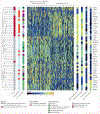Transmission of yellow fever vaccine virus through blood transfusion and organ transplantation in the USA in 2021: report of an investigation
- PMID: 37544313
- PMCID: PMC11089990
- DOI: 10.1016/S2666-5247(23)00170-2
Transmission of yellow fever vaccine virus through blood transfusion and organ transplantation in the USA in 2021: report of an investigation
Erratum in
-
Correction to Lancet Microbe 2023; 4: e711-21.Lancet Microbe. 2023 Oct;4(10):e767. doi: 10.1016/S2666-5247(23)00291-4. Epub 2023 Sep 4. Lancet Microbe. 2023. PMID: 37678293 No abstract available.
Abstract
Background: In 2021, four patients who had received solid organ transplants in the USA developed encephalitis beginning 2-6 weeks after transplantation from a common organ donor. We describe an investigation into the cause of encephalitis in these patients.
Methods: From Nov 7, 2021, to Feb 24, 2022, we conducted a public health investigation involving 15 agencies and medical centres in the USA. We tested various specimens (blood, cerebrospinal fluid, intraocular fluid, serum, and tissues) from the organ donor and recipients by serology, RT-PCR, immunohistochemistry, metagenomic next-generation sequencing, and host gene expression, and conducted a traceback of blood transfusions received by the organ donor.
Findings: We identified one read from yellow fever virus in cerebrospinal fluid from the recipient of a kidney using metagenomic next-generation sequencing. Recent infection with yellow fever virus was confirmed in all four organ recipients by identification of yellow fever virus RNA consistent with the 17D vaccine strain in brain tissue from one recipient and seroconversion after transplantation in three recipients. Two patients recovered and two patients had no neurological recovery and died. 3 days before organ procurement, the organ donor received a blood transfusion from a donor who had received a yellow fever vaccine 6 days before blood donation.
Interpretation: This investigation substantiates the use of metagenomic next-generation sequencing for the broad-based detection of rare or unexpected pathogens. Health-care workers providing vaccinations should inform patients of the need to defer blood donation for at least 2 weeks after receiving a yellow fever vaccine. Despite mitigation strategies and safety interventions, a low risk of transfusion-transmitted infections remains.
Funding: US Centers for Disease Control and Prevention (CDC), the Biomedical Advanced Research and Development Authority, and the CDC Epidemiology and Laboratory Capacity Cooperative Agreement for Infectious Diseases.
Copyright © 2023 The Author(s). Published by Elsevier Ltd. This is an Open Access article under the CC BY-NC-ND 4.0 license. Published by Elsevier Ltd.. All rights reserved.
Conflict of interest statement
Declaration of interests LFW received research funding from Accelerate Diagnostics, bioMérieux, Hardy Diagnostics, Roche Molecular Systems, and Selux Diagnostics and honoraria from Roche Molecular Systems, Shionogi, and Talis Biomedical, all unrelated to this work. KSG received research support from ThermoFisher and has a royalty-generating collaborative agreement with ZeptoMetrix, both unrelated to this work. MRW received research grant funding from Roche/Genentech and Novartis and speaking honoraria from Genentech, Novartis, Takeda, and WebMD, all unrelated to this work. CYC received research grant funding from the Bay Area Lyme Disease Foundation and the Chan-Zuckerberg Biohub, unrelated to this work, and is on the scientific advisory board for Mammoth Biosciences, Poppy Health, and BiomeSense. MRW and CYC are consultants and co-founders of Delve Bio. CYC is a co-inventor on US patent 11380421, Pathogen Detection Using Next Generation Sequencing, under which algorithms for taxonomic classification, filtering, and pathogen detection are used by SURPI+ software.
Figures




References
-
- Staples JE, Monath TP, Gershman MD, Barrett ADT. Yellow fever vaccines. In: Plotkin SA, Orenstein WA, Offit PA, Edwards KM, eds. Plotkin’s vaccines, 7th edn. Philadelphia, PA: Elsevier, 2018: 1181–265.
-
- Staples JE, Gershman M, Fischer M. Yellow fever vaccine: recommendations of the Advisory Committee on Immunization Practices (ACIP). MMWR Recomm Rep 2010; 59: 1–27. - PubMed

